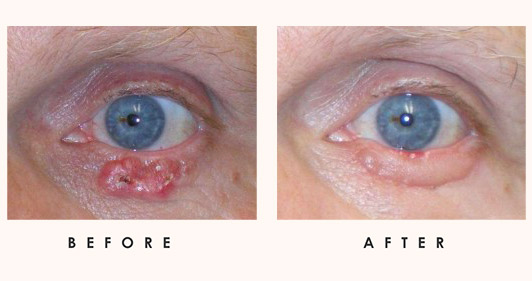Keratoacanthoma
Jump To
Sometimes, the cells in the skin can form small lesions that require treatment. Keratoacanthoma is a clinical condition where skin cells grow into a small tumor which is often localized and does not spread to any other part of the body. Below we briefly review keratoacanthoma and how it is treated.
What is a keratoacanthoma?
Keratoacanthoma is a skin tumor that appears like a small boil on the surface of the skin. Once it appears, it starts to grow rather rapidly and can reach a significant size within a matter of weeks. Untreated keratoacanthoma will eventually disappear though they will likely leave a scar. A keratoacanthoma can take up to 4 to 6 months for complete resolution.
What causes a keratoacanthoma?
The primary reason for the development of a keratoacanthoma is exposure of the skin to ultraviolet rays of the sun. A few rare cases have been linked to the human papilloma virus.
Types of keratoacanthoma
There are various types of keratoacanthoma. They can be solitary lesions (called solitary keratoacanthoma), multiple lesions (called multiple keratoacanthoma) or a rather large lesion (known as giant keratoacanthoma). Sometimes, multiple lesions might arise in different parts the body and this is known as generalized eruptive keratoacanthoma. Similarly, multiple lesions might also arise in one part of the body and this is known as keratoacanthoma centrifugum marginatum.
How is keratoacanthoma diagnosed?
Diagnosis can be easily made from history and clinical examination. Keratoacanthomas have a characteristic appearance upon inspection; a raised dome-shaped lesion with a central area of depression on a sun-exposed area like the face, ears, or hands. Confirmation may be required through additional tests. A skin biopsy is helpful and will reveal the presence of small fragments of keratin which is a part of normal skin tissue. Other additional findings will also be demonstrated which can help confirm the diagnosis. Keep in mind the lesion may appear similar to squamous cell cancer, which is a more serious skin condition.
Treatment options
There are different treatment options available in managing keratoacanthoma. The choice of treatment depends upon the location of the tumor. When the tumor is located on the trunk, arms and legs, simple procedures such as curettage and electrodesiccation are sufficient. If the lesions occur on the face, a special surgical procedure known as Mohs surgery is performed. Here, the entire keratoacanthoma is removed along with the surrounding skin margins in order to prevent it from recurring.
In the event that multiple keratoacanthomas develop on the skin, surgical options may not be appropriate and using drugs such as isotretinoin may be helpful. Steroids and other special medication such as methotrexate and bleomycin have been used with a degree of success. Treatment is best offered by expert dermatologists who have managed patients with keratoacanthomas in the past. The input of a plastic surgeon might be required.
Unfortunately, patients who suffer a keratoacanthoma can experience recurrences despite adequate medical and surgical therapies.
Conclusion
A keratoacanthoma is a low-grade skin tumor that can be localized or spread all across the body. Treatments are variable and depend upon the site and number of the tumors. Long-term outcomes are good though recurrence rates are high.



